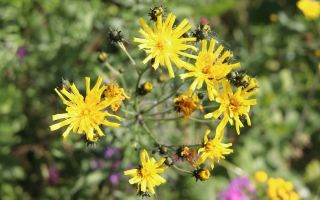Content
The medicinal properties of the umbrella hawk are beneficial for acute and chronic diseases. Before using a medicinal plant, you need to familiarize yourself with its features and rules of use.
What it looks like and where it grows
The umbrella hawk (Hieracium umbellatum) is a perennial herb from the Asteraceae family. It has a short root and one or more stems, shoots are pubescent with hairs, in the lower part they can be lignified, purple-red. The leaves of the umbellate hawk are lanceolate or narrow-linear. The lower surface of the plates is covered with stellate hairs, and the upper one usually has scattered cobweb pubescence.
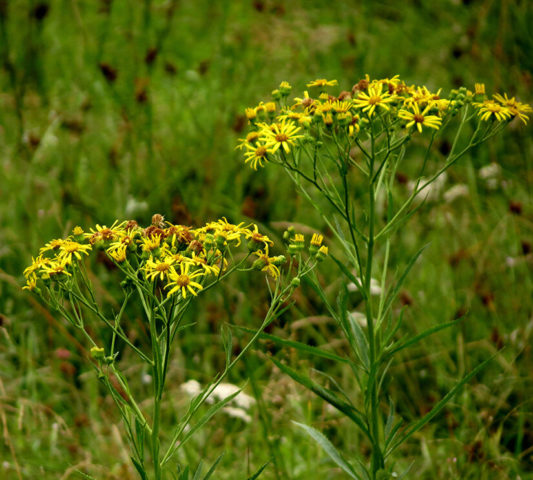
From May to August, the hawk produces light yellow buds, collected in umbellate or paniculate inflorescences. The fruits of the plant are cylindrical achenes of black color about 2 mm long.
The umbrella hawk is widespread throughout Eurasia and North America. Grows mainly in light pine and mixed forests, meadows, prefers grainy and sandy soils.
Chemical composition
The umbrella hawk is of increased interest in traditional medicine due to its rich chemical composition. The following valuable substances are present in the green parts of the plant:
- coumarins;
- caffeic and chlorogenic acids;
- tanning components;
- bitterness and tar;
- vitamin C;
- the flavonoids luteolin, isorhamnetin and apigenin;
- carotenoids;
- umbelliferone;
- mucus;
- molybdenum, zinc and manganese;
- rubber.
Medicinal use of the plant requires careful adherence to dosages. But when used correctly, the hawk is capable of having a very beneficial effect on the state of the body.
The healing properties of the hawk
The medicinal hawk has anti-inflammatory, hemostatic and healing properties. When consumed by prescription, the medicinal plant:
- normalizes the monthly cycle in women and regulates the volume of secretions;
- improves the condition with gastrointestinal ailments and liver diseases;
- helps with jaundice;
- eliminates edema and improves kidney function;
- has a beneficial effect on urolithiasis and prostatitis in men;
- promotes the healing of skin lesions;
- fights inflammatory processes;
- cleans purulent wounds;
- stops bleeding;
- has an astringent effect and helps with diarrhea;
- relieves pain in rheumatism, arthritis and bruises;
- restores strength in case of chronic fatigue;
- improves blood composition and strengthens blood vessels;
- relieves headache;
- promotes recovery from influenza, acute respiratory viral infections, bronchitis and pneumonia.
It is possible to use medicines based on the umbrella hawk for eye inflammation, sore throat and bleeding gums.Decoctions and infusions are used for rinsing and rinsing. The umbrella hawk strengthens the immune system and prevents the development of colds.
Preparation and application methods
Traditional medicine offers several algorithms for processing the umbrella hawk. On the basis of medicinal herbs, preparations are prepared for internal and external use.
Infusion
In case of inflammatory diseases and ailments of the stomach and intestines, an aqueous infusion of the umbrella hawk is prepared. The recipe looks like this:
- 10 g of a dry plant is poured into 500 ml of boiling water;
- close with a lid and leave to infuse for three hours;
- filter through folded gauze.
The finished medicine is taken three times a day, 50 ml each. It must be drunk on an empty stomach about half an hour before eating, the drug can be slightly warmed up before use.
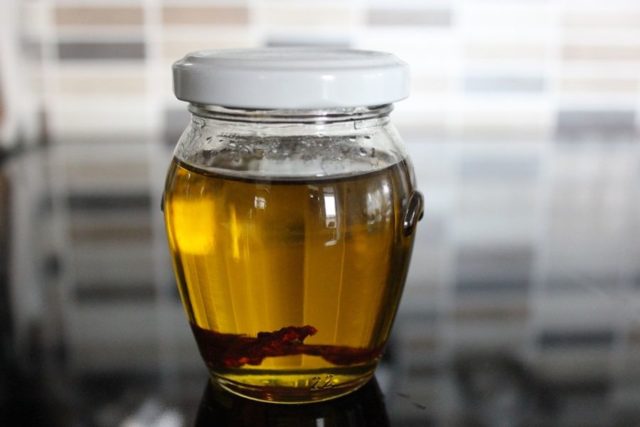
Tincture
For external and internal use, you can prepare a hawkworm tincture. The recipe looks like this:
- 10 g of dry raw materials are poured into 100 ml of vodka;
- in a closed container, remove to a dark place for ten days;
- the contents of the vessel are shaken from time to time;
- when ready, filter the product and squeeze out the rest.
You need to take alcohol tincture 15 drops up to three times a day on an empty stomach. It is beneficial for peptic ulcers, bladder stones and malaria.
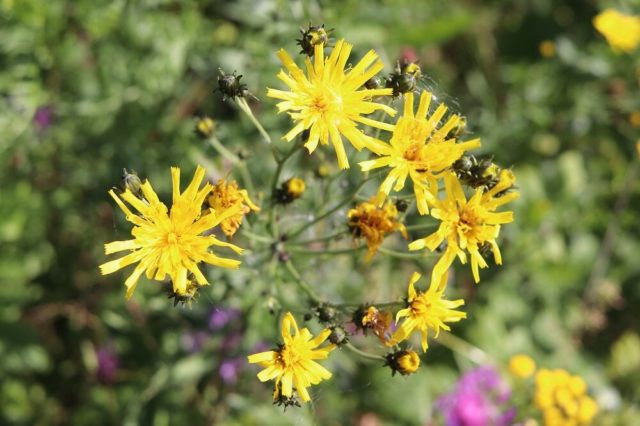
Decoction
A decoction of the umbrella hawk has strong anti-inflammatory properties. It is used to wash the eyes with conjunctivitis and mucosal damage. A product is prepared according to the following algorithm:
- pour 10 g of dried raw materials 200 ml of liquid;
- simmer on low heat after boiling for 20 minutes;
- cool under the lid and filter.
In the finished product, a piece of gauze is moistened and the inflamed eyes are gently washed. Also, the broth can be taken orally for diseases of the stomach and intestines, the dosage is 30 ml three times a day.

Powder
For the preparation of medicines and in its pure form, a powder from the leaves of the plant is used. Do it like this - grind dry plates with a mortar until a homogeneous mass is obtained.
You can use the remedy 5 g three times a day in the treatment of jaundice. The powder is used in the creation of decoctions and infusions, measuring its amount in accordance with recipes. The preparation diluted with water is suitable for treating wounds and cuts.
The juice
In inflammatory processes and gastric ailments, the fresh juice of the umbrella hawk is beneficial. To obtain it, it is necessary to grind the leaf plates of the plant by hand or in a blender, and then squeeze the resulting gruel through cheesecloth.
The juice is consumed in 30 drops three times a day on an empty stomach, washed down with water. It can also be used to lubricate cuts and healing burns.
Ointment
For joint and skin ailments, a homemade ointment based on hawk grass is beneficial. Prepare it like this:
- chop dry or fresh leaves and stems of the plant;
- mixed with melted pork fat in a 1: 4 ratio;
- bring to complete homogeneity.
The resulting product is used to treat sore joints and damaged areas. After application, the ointment can be covered with a warming compress.
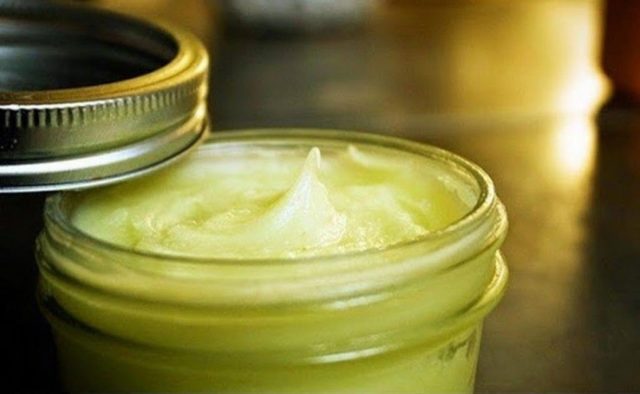
Fresh leaves
For bleeding cuts, abscesses and boils, it is allowed to use fresh hawk leaves without additional processing. The plates are washed in running water to remove dust and dirt, and then they are slightly crumpled with hands so that the juice comes out. The leaves are applied to lesions on the skin and fixed on top with a bandage.
The use of grass hawk hairy, umbrella
Traditional medicine offers many recipes based on hawk grass. When using them, you must carefully observe the proposed dosages and application regimens.
With lung diseases
With pneumonia, an infusion on the roots of the hawk has a beneficial effect. They make it according to this recipe:
- crush dry raw materials in the volume of a large spoon;
- pour a glass of boiling water and leave for two hours under the lid;
- filter through a layer of gauze.
The finished product should be consumed 45 ml three times a day before eating. The infusion not only has a beneficial effect on the respiratory system, but also helps to regulate the monthly cycle in women.
With angina
The leaves and stems of the hawk are relieving sore throat inflammation and fighting the bacterial process. The following drug is prepared for treatment:
- crushed the dried grass and measure 5 g of raw material;
- pour 100 ml of hot water into the umbrella hawk;
- when closed, leave to infuse for 15 minutes;
- filtered and cooled.
You need to take the infusion instead of regular tea twice a day. In addition, you can use it for rinsing, the agent is previously diluted in equal amounts with water.
With uremia
In chronic kidney disease and uremia caused by them, you can take an infusion on fresh leaves and stems of the umbrella hawk. Traditional medicine offers the following recipe:
- fresh grass is washed and crushed in the volume of two large spoons;
- pour raw materials with a glass of boiling water;
- close with a lid and leave for 40 minutes;
- at the end of the period, filtered.
The prepared product is taken three times a day, 30 ml each.
For kidney and bladder stones
Umbrella hawk is diuretic and helps remove small stones from the bladder and kidneys. For therapy purposes, alcohol tincture is used, but they do it like this:
- 10 g of dry plant flowers are measured;
- pour 100 ml of vodka;
- put away in a dark, cool place for a week;
- shake from time to time;
- after the expiration date, filtered through cheesecloth.
You need to take the drug in small dosages - 20 drops up to three times a day.

With jaundice
For the treatment of jaundice, traditional medicine recommends taking powder of dried hawk leaves. The algorithm looks like this:
- the raw material is ground with a mortar;
- 5 g of the resulting powder are measured.
You need to take the medicine in its pure form up to three times a day with a little water. Also, hawkworm powder is used for a cold, it is sucked in by the nose to release breathing.
With uterine bleeding
Umbellate hawk has hemostatic properties and helps with gynecological diseases and complicated hemorrhoids. A useful broth is prepared for medicinal use:
- 10 g of dry grass is poured into 250 ml of hot water;
- stand on the stove over low heat for five minutes;
- leave under the lid for another half hour.
The finished product is filtered and used for douching and sitz baths. It is necessary to use the broth every evening until you feel better; before carrying out the procedures, it is heated to a warm state.
For insomnia and anxiety
For nervous disorders, you can use the infusion of the umbrella hawk. Prepare it like this:
- measure out 20 g of crushed dry grass;
- 1 liter of hot liquid is poured into raw materials;
- leave under the lid to infuse until it cools completely.
The filtered agent is consumed half a glass three times a day. The drug has a beneficial effect on the emotional state and improves sleep.
Contraindications
The beneficial properties of the umbrella hawk are combined with contraindications to the use of the plant. In some cases, the herb can cause serious harm.It is not advised to use it:
- during pregnancy;
- during breastfeeding;
- in children under 12 years of age;
- in the presence of individual intolerance.
Umbrella hawk is considered safe when dosages are followed. If you use it in high volumes and do not follow the rules, side effects may develop. These include:
- nausea and vomiting;
- stomach pain;
- increased salivation and dizziness;
- headaches;
- general weakness.
When symptoms of poisoning appear, gastric lavage should be performed using activated charcoal or 0.1% potassium permanganate solution. To improve your health, you need to drink plenty of fluids. Treatment with an umbrella hawk is temporarily stopped, and subsequently dosages and rules are strictly observed.
Collection and procurement
For medicinal purposes, both the ground parts of the hawk and its roots are used. The stems, leaves and flowers of the plant are harvested in early summer during the flowering period, when the raw material contains the maximum amount of nutrients. The roots must be dug out of the soil in late autumn, during this period the grass goes into a state of dormancy, and valuable components are concentrated in its underground part.

The harvested raw material of the umbrella hawk is laid out for drying outside under a canopy in warm weather or in well-ventilated rooms. Direct rays of the sun on medicinal herbs and roots should not fall. Once the raw material begins to crumble in hand, it can be transferred to paper bags or glass jars and stored in a dark place with low humidity. For quick drying of herbs, it is allowed to use an oven, but care must be taken that the temperature in it does not rise above 50 ° C.
Conclusion
The medicinal properties of the umbrella hawk are beneficial for a wide range of diseases. In general, infusions and decoctions based on natural raw materials are considered safe. But they need to be used in strict accordance with the rules, since with an overdose of the hawk it can cause serious poisoning.

